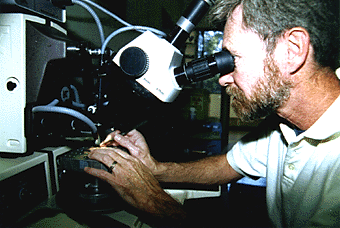![[Currents header graphic]](/homeart/currents_header.gif)
![[Currents header graphic]](/homeart/currents_header.gif)
November 10, 1997

|
|
Bill Rowe, staff research associate at the Santa Cruz Institute for Particle Physics, manually forges tiny wire bonds to a silicon chip with ultrasonic waves.
|
By Robert Irion
In the rarefied world of high-energy physics, researchers at the Santa Cruz Institute for Particle Physics (SCIPP) at UCSC have earned reputations as premier makers of tools to detect the smallest bits of matter. Now, their work on some of the most innovative physics experiments of the next decade has earned a major boost, in the form of a $208,661 grant to purchase critical pieces of equipment.
The grant consists of $156,361 from the National Science Foundation and $52,300 in matching funds from UCSC's Natural Sciences Division. With an additional $15,000 from SCIPP, the funds will pay for two devices: a probe station, which tests the silicon chips used in SCIPP's particle detectors, and an ultrasonic wire bonder, which forges bonds between the chips and intricate banks of microelectronics. Computers will run both devices, dramatically increasing quality control and the speed of research over the manual versions of these machines used at SCIPP for many years.
Huge detectors will incorporate SCIPP's chips as arrays of silicon "strips" that register the fleeting passages of charged particles. These arrays, which track particles with unparalleled accuracy, were developed mainly by SCIPP researchers.
"We have by far the most knowledgeable university-based effort on this technology," said SCIPP director Abraham Seiden, professor of physics at UCSC. "Silicon-strip detectors and their associated electronics have become our specialty."
Indeed, the U.S. Department of Energy commissioned SCIPP in 1990 to oversee construction of the innermost portion of a detector for the Superconducting Super Collider, using silicon strips. After Congress killed that project, Seiden and his colleagues were able to apply the same technology as collaborators on other planned experiments.
The new equipment, scheduled to arrive at UCSC in December, will contribute immediately to the following projects:
SCIPP researchers, led by associate professor of physics Robert Johnson, are adapting their silicon-strip techniques for the demanding environment of space. "We are developing extremely low-power and low-noise electronic amplifiers for the silicon strips," said adjunct professor of physics Hartmut Sadrozinski. "Power is a very important consideration, because we won't have an extension cord running up into orbit."
The sheer number of chips and connections in these sophisticated experiments makes it clear why SCIPP technicians need the automated equipment. Both GLAST and ATLAS will include millions of separate silicon channels. Researchers must probe each channel for reliable function and bond it to its accompanying electronics via five wires, each finer than a human hair. The projects are about 100 times larger than any SCIPP has attempted to date, Seiden said.
SCIPP scientists also will use the new equipment on at least two other projects. One is a detector for the planned "B Factory" at the Stanford Linear Accelerator Center. This machine should reveal why matter became dominant over antimatter in the earliest moments of the universe. A second project, directed by SCIPP physicist Alan Litke, will use arrays of electrodes as "retinal readout systems" to better understand how the retina processes and encodes visual images.
National Science Foundation funding for the new devices was awarded through its Major Research Instrumentation Program. Seiden noted that SCIPP received one of just three high-energy physics grants in NSF's 1997 instrumentation program.